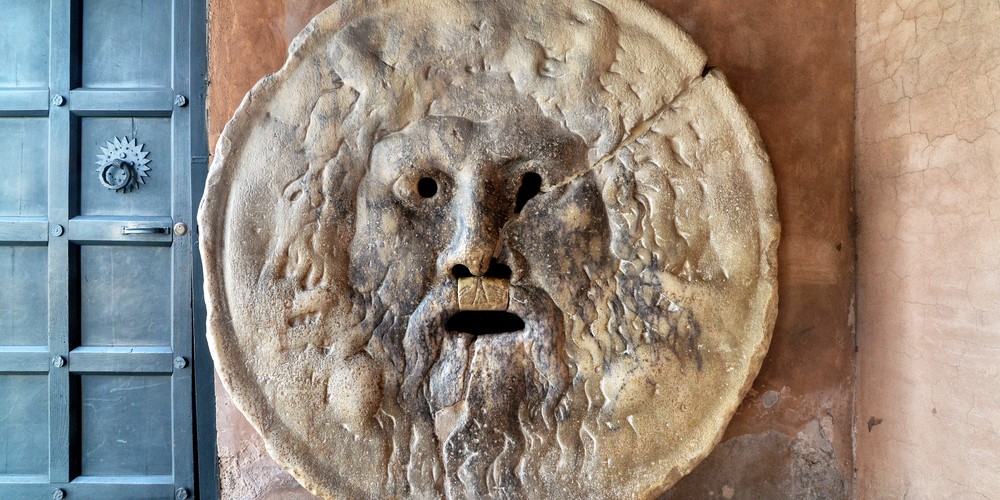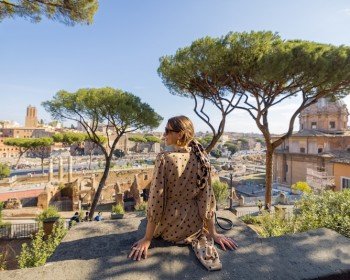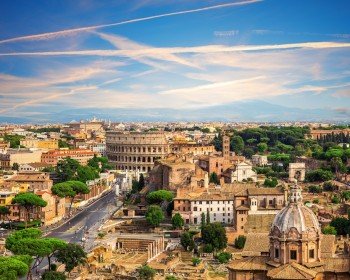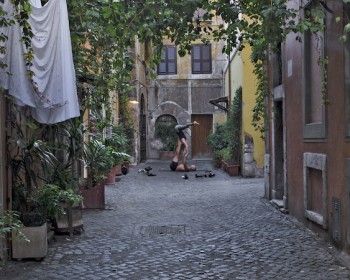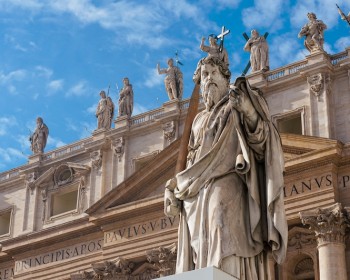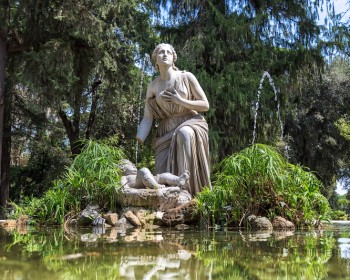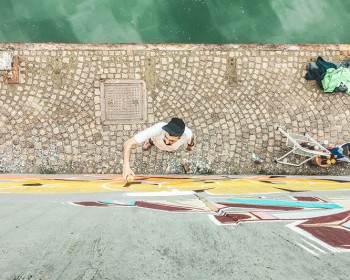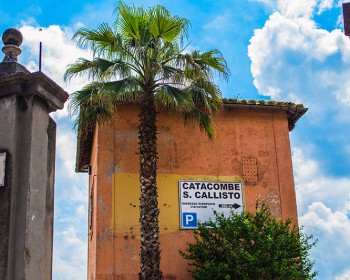Almost 2800 years old, with crossover stories fitting for a movie. What nowadays is on a film script has probably already happened in the Eternal City in the past centuries and has left a footprint on the city map. Sometimes these amazing places are a little bit out of the beaten tracks, especially if you have just a few days to explore in Rome. Here is a short list of hidden gems in Rome that, sometimes, are unknown to most of the Romans:
- Via Nicolò Piccolomini
- The Keyhole
- Gianicolo Hill
- The heart-shaped cobblestone
- Talking Statues of Rome
- Mount Testaccio district
- Pyramid of Cestius and the Protestant Cemetery
- The magic door of Victorio Square
- The mouth of Truth & the Church of Sant Maria in Cosmedin
Via Nicolò Piccolomini
The St. Peter’s Basilica Dome is probably the most photographed thing in Rome, (don’t tell the Colosseum!) and you can see it from the different iconic point of views. If you want to accept the challenge of driving in Rome don’t miss Via Piccolomini. This residential street close to the Gianicolo Hill (see below) has an amazing view of the Dome of St. Peter’s Basilica designed by Michelangelo, it will appear huge, right in front of your eyes but, there is always a but in Rome, as you start driving down the road towards it, the Dome starts to pull away thanks to an optical illusion.
Discover our -> Private Tour of Rome at Night
The Keyhole
Let’s keep talking about alternative perspectives. As I wrote above, in Rome you have many chances to see the Dome of St. Peter’s Basilica. On the Aventine Hill, a very quiet residential area surrounded by beautiful villas, a few meters far from where the Award winner “The Great Beauty” was filmed, you can find a closed gate. That’s the entrance of the Sovereign Order of Malta embassy. There is a keyhole right there waiting for you, just peek down. You will see a spectacular view of the Dome designed by Michelangelo and today shining from Sant Peter’s Basilica.
Gianicolo Hill
The highest hill in Rome, not included in the group of 7 hills where Rome was founded, is the Gianicolo hill and it is located right close to the Vatican City. In addition to taking beautiful and romantic pictures of Rome from its terrace, the Gianicolo has something else to offer. Rome is the heart of Christianity and has an unknown number of churches (somebody says nearly 500!) and at noon is like being at a bells concert or, better, was like being at a bell concert until the unification of Italy in 1870. More than a century ago a cannon was put there to report the official 12:00 PM time, so every church could start to ring the bells at the night time, and you can hear a combo sound of bells ringing and the cannon sound advising the city that noontime has arrived! Everyone, kids and adults, love his big boom.
The heart-shaped cobblestone
St. Peter’s square has witnessed many historical events and billions of feet walked over its cobblestone. Among almost 2 million cobblestones (no, it’s not a typo) there is a heart shaped one. Roman kids gave a nickname to this one of a kind pieces, “The Heart of Nero”. A small hint to find it: facing the Basilica of St. Peters’ just walk 10 meters from the central obelisk on a southwest direction and start looking down
Talking Statues of Rome
Just a few steps from Piazza Navona there is a Greek-style statue called “Pasquino”. Now look at its base and you will see hundreds of pieces of paper posted. It’s an old tradition of anonymous criticism to society, a different and safe way Romans could use to protest and be satirical. The origin of the name “Pasquino” is still unknown but it’s so famous among Romans that the statues give the name to the small square in front of it. Other “talking statues” started to appear in town later on. Besides the Pasquino in Rome there are many talking statues and each of them hide fun stories, take the chance to hunt them and learn the fun stories, there are 6 talking statues in Rome!
More about Rome secret places:
--> Palazzo Zuccari: a secret gem in Rome
Mount Testaccio district
In the south hill of the Aventine Hill there is a picturesque roman district with the building painted in red and yellow called “Testaccio“. In Testaccio, where you can taste the authentic Roman cuisine, there is an artificial hill entirely made of broken ancient Roman pottery and amphorae, everybody calls it “The Amphora Hill” or Monte dei Cocci in Roman dialect, there are more than 50 million amphora sherds from ancient Roman times! The site is huge as it measures 22000 square meters and is nearly 40-meter high. The majority of these amphorae contained olive oil, a traditional dressing of the Mediterranean diet since the very first days of the city life.
Pyramid of Cestius and the Protestant Cemetery
Testaccio district is bordered by San Paolo district, the name of this area comes from the presence of the Vatican Basilica of St. Paul Outside the Walls. As soon as you visit this area a question will come to your mind: “Am I traveling in Italy or in Egypt?”. You will be amazed by the 110 feet tall pyramid dating the 12 B.C. and built on request of Gaius Cestius, a man member of one of the most powerful religious orders of the Roman Republic Age. Nowadays is open to the public every second and fourth Saturday of each month. The Pyramid is so famous in the area that the local metro station has been named after it. Next to the Pyramid there is a protestant cemetery from the 18th century; inside there are many monumental tombs including the one of the English poet John Keats and the ashes Percy Bysshe Shelley. You will also see the Aurelian Walls that once were about 9 miles long. Do not miss to visit this area while in Rome.
The magic door of Victorio Square
The Esquiline hill has a large square called Piazza Vittorio located not that far from Termini train station; the main railroad station of Rome. The area is today called the ethnic and china town area of Rome and it is surrounded by many different kinds of stores. Right in the middle of the square there are some Roman ruins and a green area; what may surprise you is the so-called “Magic Door” or “Alchemical Door”. The door is the only one out of the 5 doors of Villa Palombara. Above the Alchemic Door there are two triangles that overlap with each other and also there are some Latin inscriptions. The Gate is dating back to the 1600s and the owner Marquis Massimiliano Palombara was passionate of alchemy and he was assisting to the meetings organized in late 1600 by the Arcadia Academy founded by the Queen Christine of Sweden. It is believed that the door preserves the secret of the Philosopher’s Stone! Have Fun and try to solve the enigma graven on it. Good luck!
The mouth of Truth & the Church of Sant Maria in Cosmedin
Not far from the Tiber River and the Aventine Hill there is the Mouth of Truth. The Mouth of Truth became very famous thank to the American movies but in reality the mouth of Truth is a marble round mask weighting over a ton and it is located in the porch of the Church St. Mary of Cosmedin. The legend recalls the late Roman and medieval period where people believed that the mouth was biting their hands if they were saying a lie. Kids love to test the mouth of truth putting their hands inside!
The church of Santa Maria in Cosmedin also preserves some relics of the Saint that is very much celebrated by the lovers every 14th of February. His name is Sant Valentine who was martyrized by the Emperor Aureliano the 14th of February 273 A.D. Saint Valentine was a bishop of Terni and during his Mass he was donating flowers to the lovers and he was blessing their wedding and their love. Saint Valentine became the Patrons of the Lovers and his day is celebrated every 14th of February the date of his Martyrium. If you are a couple you can discover many places related to Saint Valentine in Rome!
